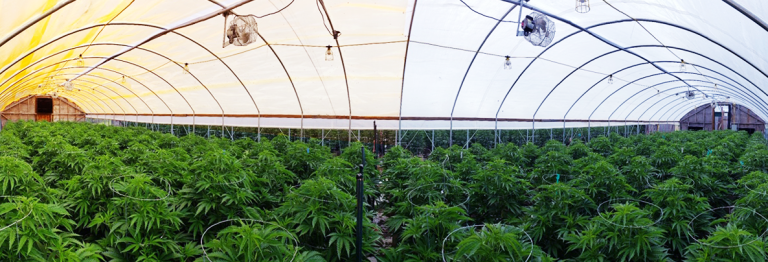After three months under the films, dry, trimmed harvest weights were reported in September of 2019. Dry yield showed an extra 2.5 lbs harvested from under the film, equivalent to a +5.4% increase in total dry yield.
+5.4% Boost in Cannabis
Case Study from | UbiGro
ABOUT THE PROJECT
UbiGro® films were installed at Little Hill Cultivators farm in Trinity County, California. The films were mounted flush against the inside polyethylene cover of half of a 20’x108’ greenhouse. The UbiGro film covered 133 cannabis plants while the other half of the greenhouse had no UbiGro film and served as the control for the trial. The number of control plants matched the number under the UbiGro film for a total of 266 plants that were monitored during the trial. The strain for the plant trial was the Indica-dominant Ice Cream Cake (Gelato x Wedding Cake).
All conditions were kept identical for both sides of the experiment: watering and nutrient regimen, humidity and temperature, harvesting and pruning regimen, integrated pest management regimen, etc. The cultivation team at Little Hill Cultivators made qualitative observations of the crop during the growth cycle. They noted that the plants under the UbiGro film showed an obvious enhanced vegetative growth rate, exemplified by an increase in height, width, and overall foliage, filling more aisle space than their control counterparts. After three months under the films, dry, trimmed harvest weights were reported in September of 2019. Dry yield showed an extra 2.5 lbs harvested from under the film, equivalent to a +5.4% increase in total dry yield. No differences in trichome color, finishing time, bud color, bud odor/flavor, or overall quality were observed.

Specimens from both sides of the plant trial were sent to CW Analytical Laboratories (Oakland, CA) for cannabinoid and terpene testing. Total terpene content for flowers grown under the UbiGro films came back slightly increased compared to flowers grown under the control side, by +7.7% (relative). Total cannabinoid content was slightly reduced for flowers grown under the UbiGro film, by -3.5% (relative). Both of these small variations are well within the error bars of the testing accuracy, which falls about ±10% (relative). Therefore, we conclude that the UbiGro film had a negligible effect on terpene and cannabinoid content of this strain.
After ten weeks of cultivation, dry, trimmed harvest weights were reported. Dry yield measurements showed an additional 7.5 lbs of product harvested from plants under UbiGro, equivalent to a +16.0% increase in total dry yield.
Potency Summary: Ice Cream Cake
Terpenes
UbiGro: 1.4%
Control: 1.3%
Relative Change: +7.7%
Total Cannabinoids
UbiGro: 21.25%
Control: 22.02%
Relative Change: -3.5%
Economics
A yield enhancement improves the economics of a farm, but what is that yield enhancement worth to the farmer? Taking this experiment as a case study, we can calculate the value that the yield-boosting UbiGro film brings to the economics of the farm. During this trial, the full greenhouse produced 93.1 lbs of dried, trimmed cannabis, excluding the 2.5-lb boost realized by the half covered by UbiGro. The greenhouse will produce double that amount given two rounds of harvests per year. The farm wholesales trimmed cannabis for $1250/lb. This equates to $233,000 in wholesale revenue from this single greenhouse per year. A +5.4% increase in yield translates to $12,600 increased revenues per year.
To quantify the value of the increase in revenue, we must calculate the increased profit. There are variable costs associated with producing and selling this extra cannabis, including harvesting, drying/curing, trimming, packaging, and transportation. However, fixed costs are not increased with additional yield. These costs include real estate (rent/mortgage), heating/cooling, electricity, marketing, labor tied to square footage such as cleaning, seeding, vegetative labor, etc. Given that the gross margin on the baseline production of cannabis at Little Hill Cultivators is 50% (50% COGS), then we estimate a 65% gross margin on the extra production (35% COGS) realized as a result of the UbiGro spectrum. In this example, that translates to $8,170 additional profit per year from this greenhouse. Over the 4-yr life of the installed UbiGro film, the farm would benefit from $32,700 in additional profit from this greenhouse alone. If the farm adopted the UbiGro technology across all six greenhouses on site and this yield improvement was consistently realized, it could profit an additional $49,000 per year, or an additional $196,000 over the 4-yr lifetime of the films.
Greenhouse Details
Greenhouse Size: 20ft x 108ft
Increased Revenue/Year: $12,600
Increased Profit/Year: $8,170
Increased Profit over Film Life: $32,700
Increased Profit over Film Life, Farm: $196,000
The content & opinions in this article are the author’s and do not necessarily represent the views of AgriTechTomorrow
Comments (0)
This post does not have any comments. Be the first to leave a comment below.
Featured Product

